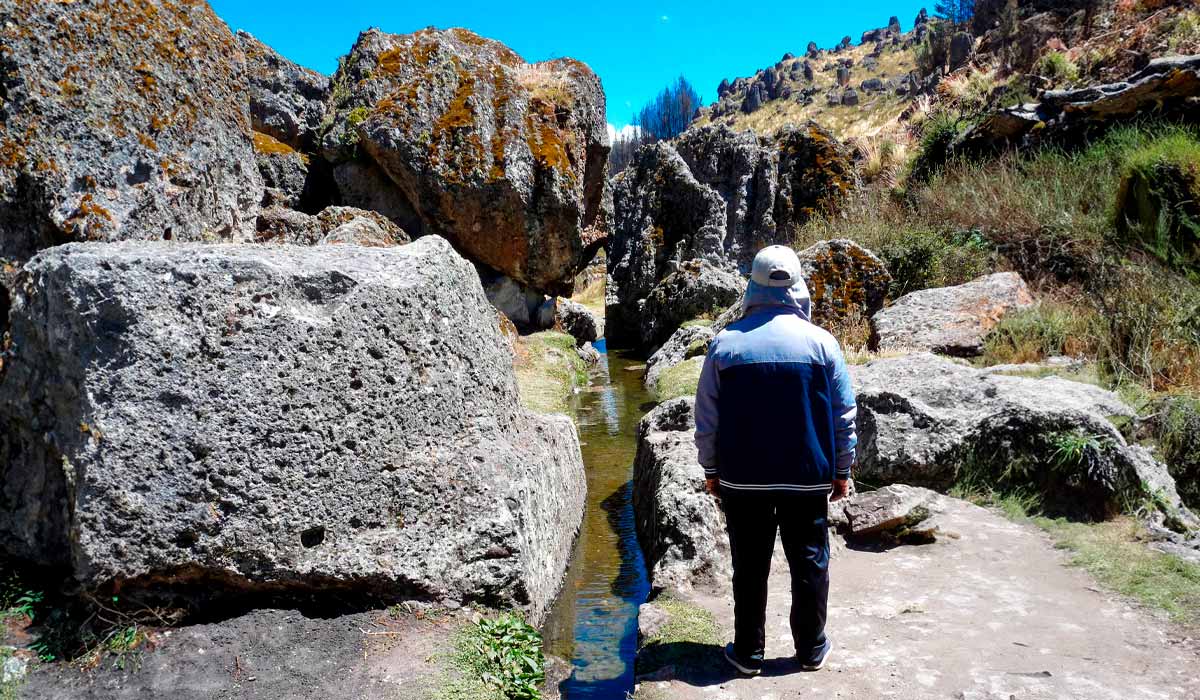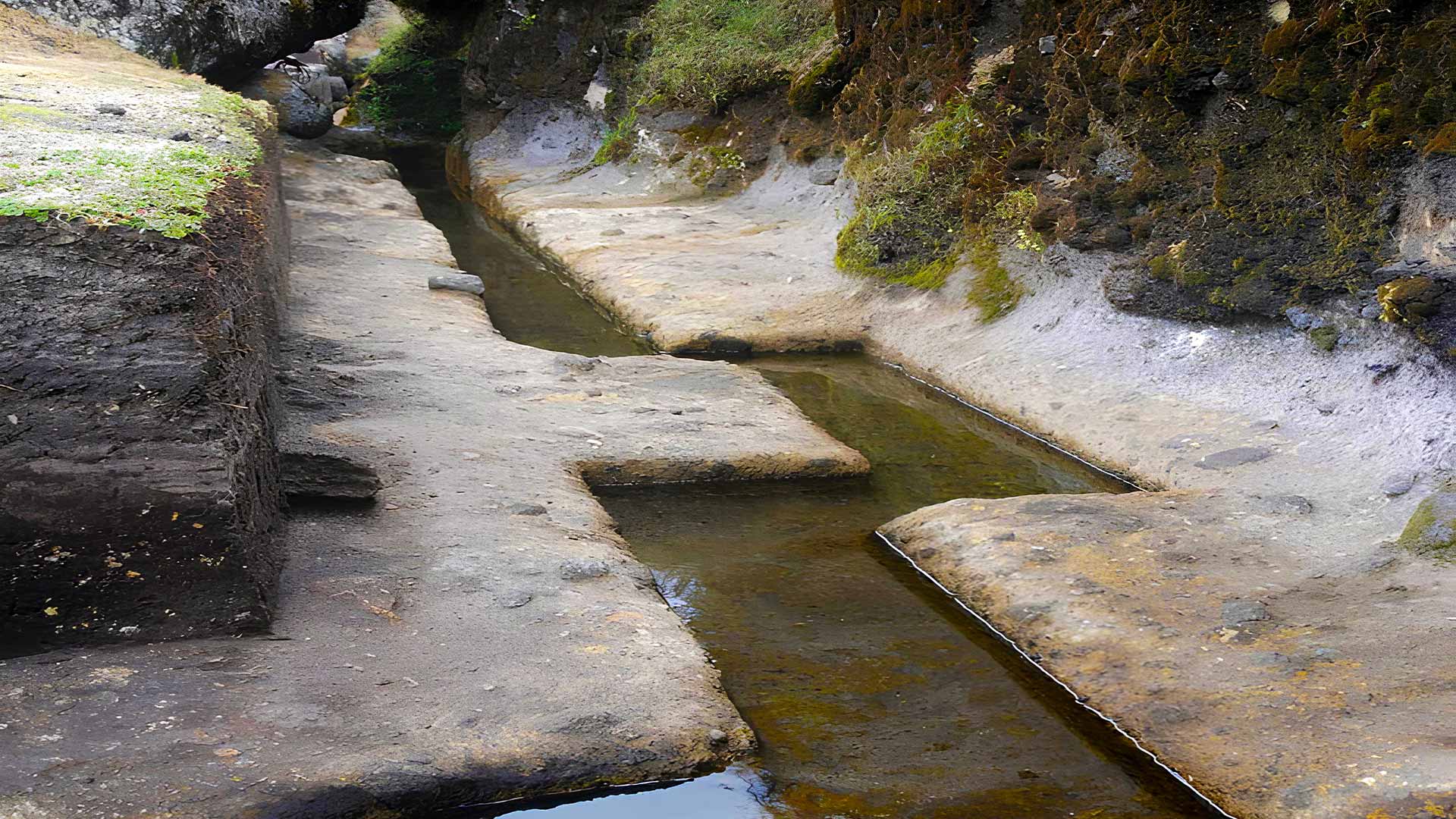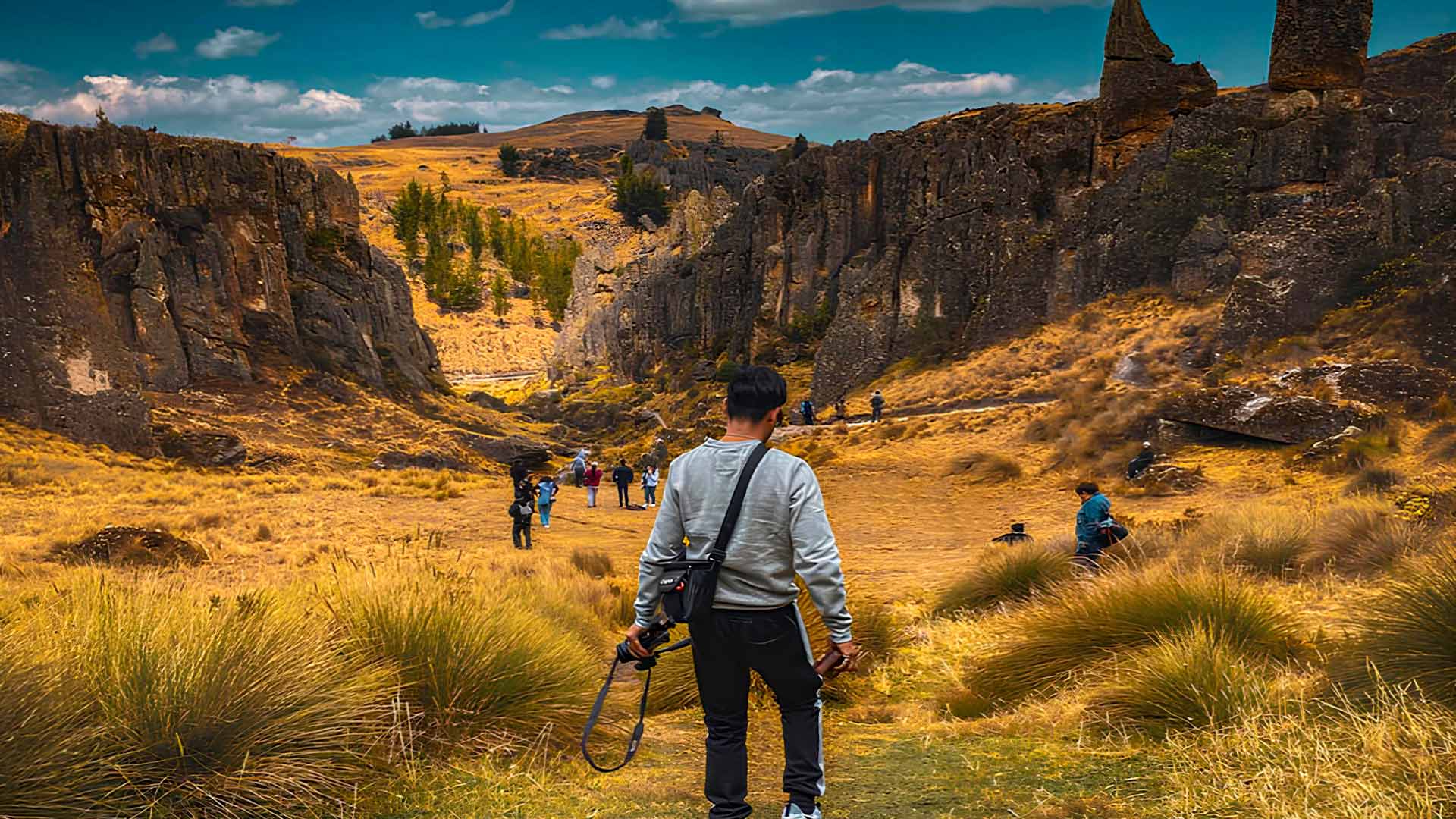The Cumbemayo complex, located in the Peruvian highlands in the department of Cajamarca, is one of the most important archaeological and geological sites in the region. This destination is known for its vast stone forest, a set of huge formations of volcanic and sedimentary origin.
The value of Cumbemayo lies in its duality. On the one hand, the geology presents rock formations that, when eroded by the wind and water, have taken on shapes interpreted as humanoid and animal figures, creating one of the most unique Peru landscapes. On the other hand, its archaeological importance centers on the Cumbemayo Aqueduct, a pre-Inca hydraulic engineering work over 3,000 years old, which was carved into rock to divert water from one slope to another.
The site is proof of the advanced hydraulic knowledge of the ancient Andean cultures. This guide is designed to provide the essential information about Cumbemayo, detailing the aqueduct, the rock formations, and the access logistics (including the exact location and altitude) needed to visit this notable ceremonial center in the Peruvian highlands.

Where is the Cumbemayo Complex located?
The Cumbemayo archaeological complex is located in the department of Cajamarca, in the Chetilla district. Geographically, it is located on the Andean high plateau, in a puna zone typical of the northern highlands of Peru. The site is situated at a considerable altitude, approximately 3,500 meters above sea level (11,480 feet), an elevation that defines its cold and dry climate.
Cumbemayo is located about 20 to 25 kilometers southwest of the city of Cajamarca, reachable by a car ride of approximately 40 to 50 minutes. Its location is important, since the famous pre-Inca aqueduct, the site's main attraction, was built in an area near the watershed, allowing its builders to divert the natural course of water from one basin to another.
Cumbemayo: Discovery and Historical-Cultural Value
The Cumbemayo complex was rediscovered in contemporary times in 1937, when a worker from the San Cristóbal Hacienda located the formations. The Peruvian archaeologist Julio C. Tello became one of the first researchers to study the complex, confirming its age and importance. Since then, the site has continued to draw the attention of historians and geologists due to the uniqueness of its structures, which are a testament to the work of the first settlers of the region.
-
Hydraulic Engineering: The Aqueduct
Cumbemayo holds an impressive pre-Inca aqueduct, a structure considered one of the oldest in South America, estimated to date back to around 1500 B.C. This monumental work of hydraulic engineering stretches for several kilometers and its main function was to divert the natural flow of water from one basin to another, showing the advanced knowledge of the ancient civilizations of Cajamarca.
The meaning of the aqueduct goes beyond the functional. The carvings (petroglyphs), the altar, the sacrifice table, and the stepped stones found along the channels suggest that this place operated as an Andean sanctuary. Offerings were made in thanks to the gods for the water, a sacred and essential element for life in the highlands. This legacy, one of the most important in the Peruvian Andes, is preserved to this day under the protection of the Ministry of Culture.
-
Cave Art and Cultural Testimonies
In addition to the aqueduct, the site holds petroglyphs and caves that are valuable testimonies of the art and culture of ancient civilizations. The images and carvings found on the rock reinforce the religious belief in water, which was considered the vital foundation of life. Excavations at the site have also revealed artifacts that have helped archaeologists place the occupation of Cumbemayo as a pre-Inca ceremonial center.
Geology and formation of Cumbemayo
This impressive place is surrounded by rocks and unique geological formations that date back thousands of years, which is why these rocks are mainly composed of diorite, a type of intrusive igneous rock with fine, dark-colored grains; What's more, the formation of this area takes place due to volcanic activity and erosion over millions of years.
- Rocks and geological formations
Cumbemayo Cajamarca is home to a wide variety of rocks and geological formations that are fascinating from a scientific point of view. Among the most common rocks in this area are diorite, andesite and slate. These rocks were formed millions of years ago due to volcanic activity and subsequent cooling; You can also see unique geological formations, such as monoliths and grooves in the rocks (these formations are the result of erosion and landscape modeling over thousands of years). - Erosion process and landscape modeling
The rocky landscape of Cumbemayo Peru has been shaped over centuries by the process of erosion, the action of wind, water and time that has shaped the rocks and created impressive geological formations. Firstly, thanks to erosion, deep grooves were carved into the rocks creating a unique and captivating appearance; Secondly, the action of water over the years has formed natural channels and waterfalls that can be observed in the area. Therefore, this continuous process of erosion and landscape modeling is what has turned Cumbemayo into a place of great geological and tourist interest.

How to get?
The Stone Forest Peru is 20 km away southwest of Cajamarca, leaving on Avenida de Perú in the direction of the Bella Vista viewpoint, the city's watchtower. From here we will continue going up the road until we reach 3,580 meters high where Cumbemayo is located.
Information about the place
Cumbemayo is an impressive stone forest located at the top of Cajamarca Peru. This place is located at an altitude of approximately 3,500 meters above sea level and has an area of 1,500 hectares, which is why it is known for its unique and mysterious landscape.
- Location and Altitude
Cumbemayo is located at the top of Cajamarca, in northern Peru. Its location is about 20 kilometers southwest of the city of Cajamarca. The place rises to an altitude of around 3,500 meters above sea level, providing stunning views of the surrounding mountains. - Cost of Entry
The entrance prices are 8 soles for adults, 4 soles for students and 1 sole for children. It is also recommended to bring cash since it is not always possible to pay with a credit or debit card. Also, keep in mind that you can find tours with a fixed route that includes admission and a guided tour, which cost around 25 soles (they also have a cheaper service for 15 soles, which only covers transportation and the guide). - Access hours
Access hours to Cumbemayo are Monday to Sunday from 8:00 a.m. to 5:00 p.m. It is important to note that access may be limited during certain periods of the year due to adverse weather conditions or special events.
About the Excursion Route
The tour on the Cumbemayo plateau focuses on exploring a landscape that combines ancient hydraulic engineering with unique geological formations. The main route allows visitors to observe the remains of the pre-Inca aqueduct, which extends for 9 kilometers, and the associated ceremonial area, which includes the altar of sacrifices and petroglyphs.
The trail crosses the narrow rocky gorge known as Los Frailones (the stone forest); on the other hand, this site is valued for its historical importance, as it was a ceremonial center of great importance from the pre-Inca period up to the Incas, and is a popular destination for high-altitude hiking and camping in the Cajamarca region.
Attractions and activities in Cumbemayo
In Cumbemayo, visitors can enjoy a variety of exciting attractions and activities, starting with the tour through the stone forest, where you can see impressive rock formations with peculiar shapes due to erosion. Likewise, tourists can visit the pre-Inca water channels, which are an amazing example of the hydraulic engineering of the ancient civilization; Last but not least, visitors can enjoy observing petroglyphs and caves, which reveal the presence of ancient cultures in the area.
- Tour through the stone forest
The tour through the stone forest in Cumbemayo is a fascinating experience, where visitors can walk among the rock formations, some of which have unusual and whimsical shapes, a product of natural elements over the years, creating fascinating landscapes and surprising. - Observation of petroglyphs and caves
In Cumbemayo, Peruvian tourists and visitors can enjoy observing petroglyphs and caves, these artistic representations engraved in the rock reveal part of the history and culture of the ancient civilizations that inhabited the region. The petroglyphs show designs and symbols that represented beliefs, activities and figures important to these cultures. What's more, the caves also have a special meaning, since it is believed that they were used as places for rituals and ceremonies.

Best time to visit
The best time to visit Cumbemayo is during the dry season, which runs from May to September, since, during these months, rain is less frequent and there is a greater chance of enjoying pleasant, clear weather. But keep in mind that it doesn't matter what dates you visit this place, since it is beautiful at any time of the year, so it is worth visiting even during the rainy season.
Best Tours in Cusco
Many are the routes that take you to Machu Picchu, but none is like the Inca Trail Tours, the most famous pedestrian path in the Americas. After flying from the capital of Perú, Lima, you will arrive in Cusco to walk for four days along a path through forests and dense fog, millenary stone steps and discovering the ruins of ancient fortifications and Inca cities, and all the time enjoying majestic views.
- Salkantay Trek to Machu Picchu 5 days
- Hiking the Inca Trail to Machu Picchu 5 days
- Inca Quarry Trail 4 Days
- 2 Day Inca Trail Tour
- 2 Day Inca Trail with Camping
- 3 Day Inca Trail
- Vilcabamba Hike to Machu Picchu 6 days
- Choquequirao trek to Machu Picchu 9 days
- Ausangate trek 7 days
If you want to visit Machu Picchu, we recommend you to book your Machu Picchu Ticket in advance, so you will enjoy your Vacation in Machu Picchu without any problem.







